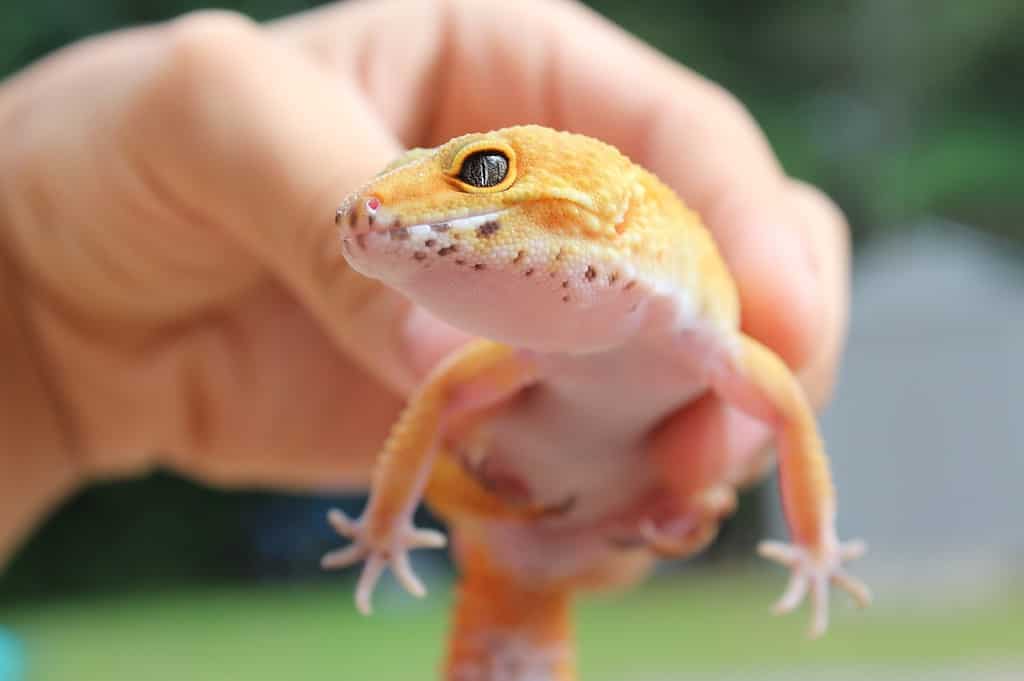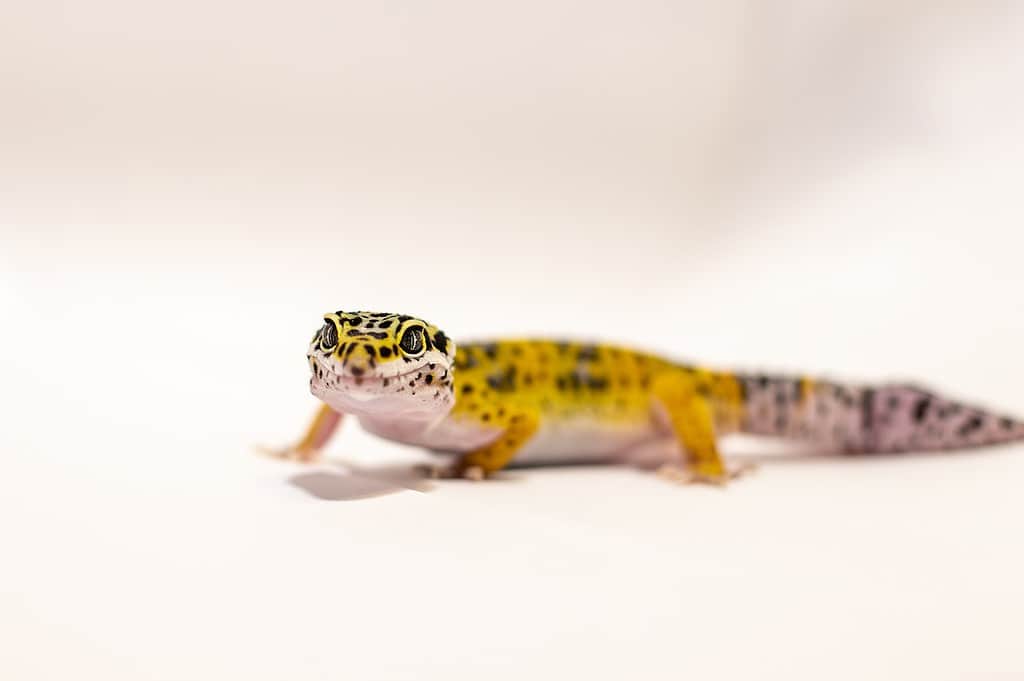It is painful to lose a pet; sometimes, it may feel like you’ve lost a close friend. Leopard Geckos are sturdy, resilient, and long-lived; thus, many pet owners choose them. Leopard geckos not given the appropriate care run the risk of becoming ill. In that context, let us discuss all about the dying Leopard Geckos signs so that you may know well before the time that your pet Leo is going to depart you from this world.

If you see that your gecko is acting strangely, has lost a significant amount of weight quickly, or is sluggish with little or no activity, you may suspect leopard gecko dying symptoms.
Leopard geckos have a slower metabolism, and when they become unwell, they frequently do not exhibit symptoms until the disease has severely developed.
This post will discover leopard gecko dying indications, how to treat your pet, and when to visit the clinic.
Leopard Geckos and the Process of Dying
The care required for leopard geckos is typically minimal, making them a popular choice for new owners of reptiles. Despite their environment needing special temperature settings, surroundings, nutrition, and care, they often have minimal health issues.
There are certain things to consider while setting up a leopard gecko habitat or caring for an existing one. Leopard gecko owners worry about lethargy, shedding, and brumation.
You must look for many things to determine the overall health of your leopard gecko, although some of the signs of shedding and structure may be similar to how a leopard gecko dies.
If their habitat is kept clean and they receive the attention and care they need, leopard geckos typically have a good chance of living a long and healthy life.
Leopard Gecko Dying Symptoms
Dying leopard geckos display weight loss, sunken eyes, loss of appetite, and lethargy. Other symptoms include bleeding from the lips and runny or foul droppings.
Loss of Appetite
A loss of appetite is one of the most significant signs that your gecko is becoming ill. A leopard gecko’s loss of appetite might be caused by a number of things, including an unsuitable temperature, improper nutrition, and stress.
Check the temperature inside their enclosure and make sure it is set appropriately. To ensure that they digest their food effectively, leopard geckos require a heater to be installed underneath their tank.
Then you can check to see if there is something in their environment that could make them feel stressed and cause them to lose their appetite. Each of these things has the potential to be a cause of anxiety and contribute to a decreased interest in food.
Abnormal Or No Droppings
Examining your leopard gecko’s droppings might be one of the most effective ways to determine whether or not it is sick or dying. They may suffer from impaction if they have unusual or fewer droppings than usual.
Impaction is a common cause of unexpected death in leopard geckos. If your pet leopard gecko consumes anything that causes digestive troubles and other internal disorders, your pet’s digestive tract and other organs might get affected.
If you discover that your leopard gecko is affected by this condition at an early stage, it will be simple for you to treat it. However, if you do not recognize the symptoms on time, it might result in the death of your leopard gecko.
Sunken Eyes
If you see that the eyes of your leopard gecko have begun to sink into their body, this is a sign that they are suffering from a lack of water. Dehydration causes underlying health issues in leopard geckos and can reduce appetite and illness.
The sticky mucus in the leopard gecko’s mouth and retained, non-shedding skin are two more indicators that the animal is dehydrated. On the other hand, sunken eyes are the most obvious sign.
To prevent them from dehydrating, the water in their tank has to be fresh, and there should be sufficient of it. In addition, you need to ensure that the enclosure has an appropriate degree of humidity throughout its whole.
Dehydration
In order to keep themselves alive, leopard geckos require water in addition to the food they eat. Geckos can have more subtle, difficult-to-detect signs of dehydration than other animals. Dehydration causes dry, flaky skin, wrinkled skin, sunken eyes, muscle loss, and fatigue. To avoid these symptoms, ensure your leopard gecko always has clean water in its habitat.
Disinterest or Listlessness
If your leopard gecko is typically curious, engaged, and active, you can be assured that it is a healthy and happy pet. You could see them exploring their enclosure, looking for prey, or relaxing in warm spots in the environment.
Your leopard gecko may be unwell if it stays in one area for long periods or hides behind or beneath tank objects. If you observe that your gecko is acting more passive or less attentive than usual, your best choice is to take them to a veterinarian as soon as possible.

Causes of Death & Illness in Leopard Geckos
Regrettably, leopard geckos or other reptiles show almost no symptoms of illness. Consider yourself fortunate if the reptile exhibits even the slightest disease. Therefore, illness symptoms are typically modest and readily mistaken with other normal symptoms.
Here are some of leopard geckos’ most prevalent causes of death and disease.
Impaction
Impaction is a life-threatening condition that can result in the leopard gecko’s death. It is the most common reason for the leopard gecko’s unexpected death. Impaction is a condition that can occur if your leopard gecko mistakenly consumes hard material, an insect that is too large, or an insect with a hard shell. Impaction is another risk that might arise if you do not provide your leopard gecko enough area for sunbathing.
You are aware that higher temperatures make digestion easier for your leopard gecko. If your leopard gecko doesn’t have sufficient heat to digest food, its stomach contents might clog its intestines, leading to death.
Consider giving your leopard gecko a warm bath if you see any of these symptoms. In addition, you should never hesitate to contact your local veterinarian if you observe any of these symptoms or signs.
Metabolic Bone Disease (MBD)
A deficiency in vitamin D or other essential minerals may be the underlying cause of metabolic bone disease. After a leopard gecko has been deprived of these minerals and nutrients for an extended period, its skeleton will become flexible and even deformed.
Because of this, the leopard gecko has difficulty moving around and eating its food. You can’t cure metabolic bone disease but you can stop it by providing your leopard gecko calcium and vitamin D3.
Younger leopard geckos are more likely to suffer from the metabolic bone disease than older leopard geckos. Give your leopard gecko appropriate growth vitamins during the first year of life.
External Parasites
When it comes to external parasites, mites are most likely the most prevalent things you may come across when caring for leopard geckos. This parasite resembles a tiny tick and will feed on the blood of your leopard gecko by biting its skin.
If your leopard geckos have mites, you may notice damaged skin, increased wetting, decreased hunger, weight loss, shedding difficulties, and white dust in the habitat.
Visit your vet as soon as possible if you observe any of these symptoms to acquire an official diagnosis. Your vet can determine the parasite and illness from your leopard gecko’s feces sample.
How to Avoid Leopard Gecko Getting Sick
After understanding gecko illnesses and deaths, let’s look at prevention measures.
- Clean your gecko’s cage often and remove droppings.
- Provide your gecko with suitable food; acquire a range of insects from reputable suppliers or raise your own.
- Practice good hygiene while handling your leopard gecko; wash your hands after contacting another pet to avoid disease or parasites.
